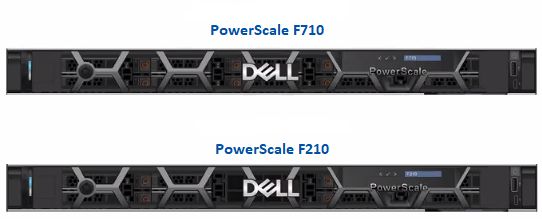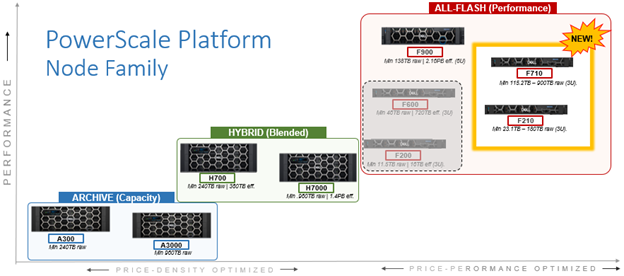Hot on the heels of the recent OneFS 9.7 release sees the launch of two new PowerScale F-series hardware offerings. Between them, these new F710 and F210 all-flash nodes add some major horsepower to the PowerScale stable.

Built atop the latest generation of Dell’s PowerEdge R660 platform, the F710 and F210 each boast a range of Gen4 NVMe SSD capacities, paired with a Sapphire Rapids CPU, a generous helping of DDR5 memory, and PCI Gen5 100GbE front and back-end network connectivity – all housed within a compact, power-efficient 1RU form factor chassis.
Here’s where these new nodes sit in the current hardware hierarchy:

As illustrated in the greyed out region of the above chart, these new nodes refresh the current F600 and F200 platforms, and further extend PowerScale’s price-performance envelope.
The PowerScale F210 and F710 nodes offer a substantial hardware evolution from previous generations, while also focusing on environmental sustainability, reducing power consumption and carbon footprint. Housed in a 1RU ‘Smart Flow’ chassis for balanced airflow and enhanced cooling, both new platforms offer greater density than their F600 and F200 predecessors – the F710 now accommodating ten NVMe SSDs per node and 25% greater density, and the F210 now offering NVMe drives with a 15.36 TB option, and doubling the F200’s maximum density. Both platforms also include in-line compression and deduplication by default, further increasing their capacity headroom and effective density. Plus, using Intel’s 4th gen Xeon Sapphire Rapids CPUs results in 19% lower cycles-per-instruction, while PCIe Gen 5 quadruples throughput over Gen 3, and the latest DDR5 DRAM offers greater speed and bandwidth – all netting up to 90% higher performance per watt. Additionally, the F710 and F210 debut a new 32 GB Software Defined Persistent Memory (SDPM) file system journal, in place of NVDIMM-n in prior platforms, thereby saving a DIMM slot on the motherboard too.
On the OneFS side, the recently launched 9.7 release delivers a dramatic performance bump – particularly for the all-flash platforms. OneFS 9.7 benefits from latency-improving enhancements to its locking infrastructure and protocol heads – plus ‘direct write’ non-cached IO, which we will explore in a future article.
This combination of generational hardware upgrades plus OneFS 9.7 software advancements results in dramatic performance gains for the F710 and F210 – particularly for streaming reads and writes, which see a 2x or greater improvement over the prior F600 and F200 platforms. This makes the F710 and F210 ideal candidates for demanding workloads such as M&E content creation and rendering, high concurrency and low latency workloads such as chip design (EDA), high frequency trading, and all phases of generative AI workflows, etc.
Scalability-wise, both platforms require a minimum of three nodes to form a cluster (or node pool), with up to a maximum of 252 nodes, and the basic specs for the new nodes include:
| Component | PowerScale F710 | PowerScale F210 |
| CPU | Dual–socket Intel Sapphire Rapids, 2.6GHz, 24C | Single–socket Intel Sapphire Rapids, 2GHz, 12C |
| Memory | 512GB DDR5 DRAM | 128GB DDR5 DRAM |
| SSDs per node | 10 x NVMe SSDs | 4 x NVMe SSDs |
| Raw capacities per node | 38.4TB to 307TB | 7.7TB to 61TB |
| Drive options | 3.84TB, 7.68TB TLC and 15.36TB, 30.72TB QLC | 1.92TB, 3.84TB, 7.68TB TLC and 15.36TB QLC |
| Front-end network | 2 x 100GbE or 25GbE | 2 x 100GbE or 25GbE |
| Back-end network | 2 x 100 GbE | 2 x 100GbE or 25GbE |
Note that, while the F210 can coexist with the F200 in the same node pool, the F710 does not currently have any node pool compatibility peers.
Over the next couple of articles, we’ll dig into the technical details of each of the new platforms. But, in summary, when combined with OneFS 9.7, the new PowerScale all-flash F710 and F210 platforms quite simply deliver on efficiency, flexibility, performance, and scalability.